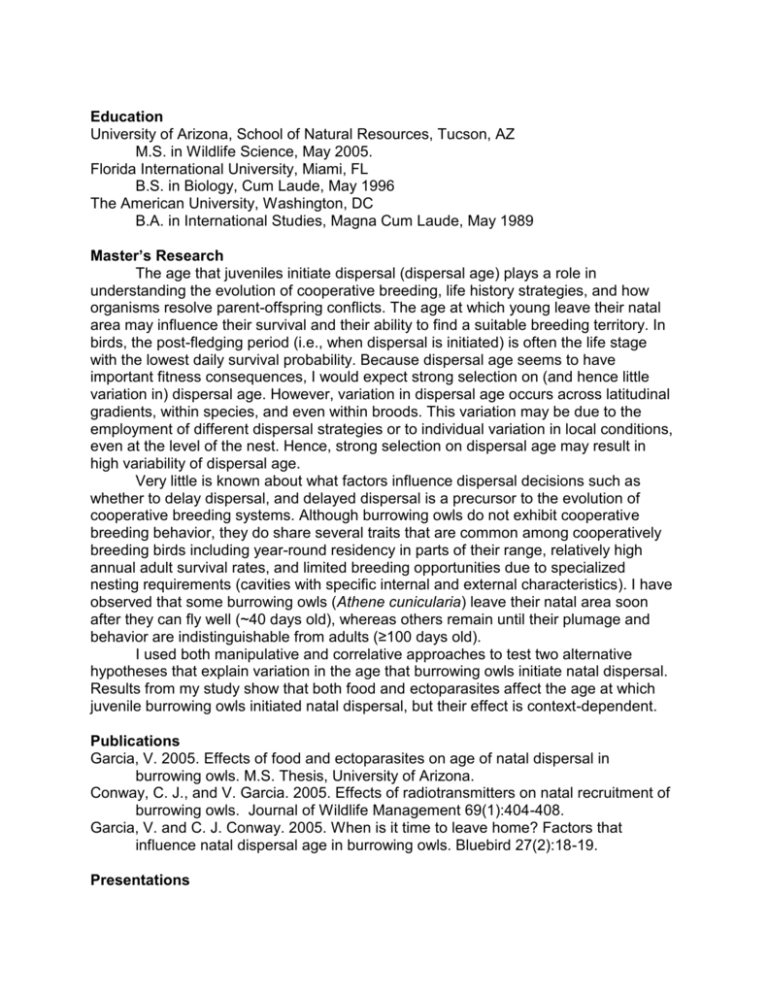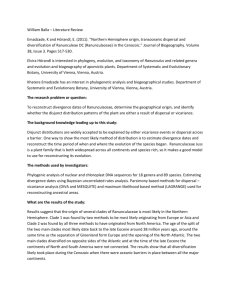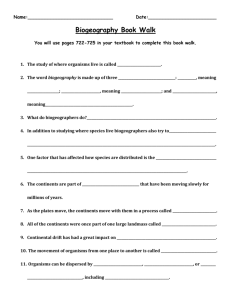Victoria Garcia - University of Arizona
advertisement

Education University of Arizona, School of Natural Resources, Tucson, AZ M.S. in Wildlife Science, May 2005. Florida International University, Miami, FL B.S. in Biology, Cum Laude, May 1996 The American University, Washington, DC B.A. in International Studies, Magna Cum Laude, May 1989 Master’s Research The age that juveniles initiate dispersal (dispersal age) plays a role in understanding the evolution of cooperative breeding, life history strategies, and how organisms resolve parent-offspring conflicts. The age at which young leave their natal area may influence their survival and their ability to find a suitable breeding territory. In birds, the post-fledging period (i.e., when dispersal is initiated) is often the life stage with the lowest daily survival probability. Because dispersal age seems to have important fitness consequences, I would expect strong selection on (and hence little variation in) dispersal age. However, variation in dispersal age occurs across latitudinal gradients, within species, and even within broods. This variation may be due to the employment of different dispersal strategies or to individual variation in local conditions, even at the level of the nest. Hence, strong selection on dispersal age may result in high variability of dispersal age. Very little is known about what factors influence dispersal decisions such as whether to delay dispersal, and delayed dispersal is a precursor to the evolution of cooperative breeding systems. Although burrowing owls do not exhibit cooperative breeding behavior, they do share several traits that are common among cooperatively breeding birds including year-round residency in parts of their range, relatively high annual adult survival rates, and limited breeding opportunities due to specialized nesting requirements (cavities with specific internal and external characteristics). I have observed that some burrowing owls (Athene cunicularia) leave their natal area soon after they can fly well (~40 days old), whereas others remain until their plumage and behavior are indistinguishable from adults (≥100 days old). I used both manipulative and correlative approaches to test two alternative hypotheses that explain variation in the age that burrowing owls initiate natal dispersal. Results from my study show that both food and ectoparasites affect the age at which juvenile burrowing owls initiated natal dispersal, but their effect is context-dependent. Publications Garcia, V. 2005. Effects of food and ectoparasites on age of natal dispersal in burrowing owls. M.S. Thesis, University of Arizona. Conway, C. J., and V. Garcia. 2005. Effects of radiotransmitters on natal recruitment of burrowing owls. Journal of Wildlife Management 69(1):404-408. Garcia, V. and C. J. Conway. 2005. When is it time to leave home? Factors that influence natal dispersal age in burrowing owls. Bluebird 27(2):18-19. Presentations Garcia, V., and C. J. Conway. 2005. What is a nest? Influence of nest definition on estimates of nesting success in Burrowing Owls. Oral presentation, American Ornithologists' Union Annual Meeting, Santa Barbara, CA. Garcia, V. and C. J. Conway. 2004. Ultimate factors affecting initiation of natal dispersal in burrowing owls. Oral presentation, American Ornithologists’ Union Annual Meeting, Quebec City, Quebec. Garcia, V. and C. J. Conway. 2003. Effects of food and ectoparasites on dispersal age. Poster presentation, American Ornithologists’ Union Annual Meeting, UrbanaChampaign, IL. Garcia, V. and C. J. Conway. 2003. Effects of food and ectoparasites on age of natal dispersal in burrowing owls. Oral presentation, Cooper Ornithological Society Annual Meeting, Flagstaff, AZ. Garcia, V. and C. J. Conway. 2002. Effects of habitat and landscape features on survival, reproductive success, and dispersal of Burrowing Owls. Oral presentation. USGS Cooperators Meeting, Tucson, AZ. Grants Mewaldt-King Student Research Award, Cooper Ornithological Society, 2004 Student Travel Award from the American Ornithologists’ Union, 2004 North American Bluebird Society Research Grant, 2003 Frank M. Chapman Memorial Grant, American Museum of Natural History, 2003 Silliman Memorial Research Award, University of Arizona, 2003, 2004 Budweiser Conservation Scholarship, 2002-2003 Student Membership Grant from Cooper Ornithological Society, 2002, 2003 2 V. Garcia resume







![[CLICK HERE AND TYPE TITLE]](http://s3.studylib.net/store/data/006863514_1-b5a6a5a7ab3f658a62cd69b774b6606c-300x300.png)

